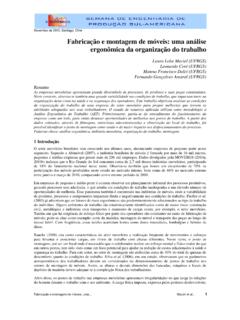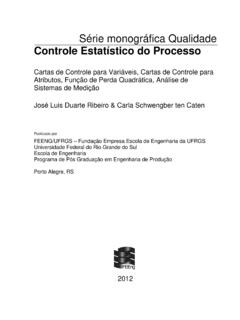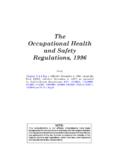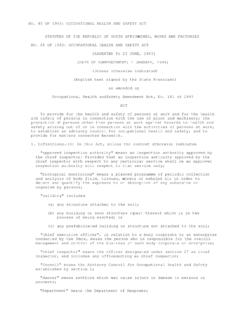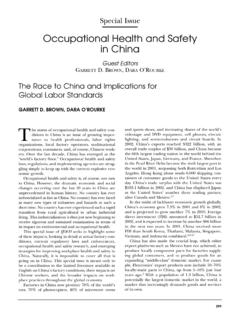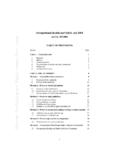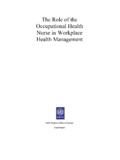Transcription of Occupational Health and Safety Management …
1 OHSAS 18001:2007 Occupational Health AND Safety ASSESSMENT SERIES Note: This document is to be used for training only. Page 1 of 28 Occupational Health and Safety Management Systems Requirements OHSAS 18001:2007 Occupational Health AND Safety ASSESSMENT SERIES Note: This document is to be used for training only. Page 2 of 28 INTRODUCTION Organizations of all kinds are increasingly concerned with achieving and demonstrating sound Occupational Health and Safety (OH&S) performance by controlling their OH&S risks, consistent with their OH&S policy and objectives.
2 They do so in the context of increasingly stringent legislation, the development of economic policies and other measures that foster good OH&S practices, and increased concern expressed by interested parties about OH&S issues. Many organizations have undertaken OH&S reviews or audits to assess their OH&S performance. On their own, however, these reviews and audits may not be sufficient to provide an organization with the assurance that its performance not only meets, but will continue meet, its legal and policy requirements.
3 To be effective, they need to be conducted within a structured Management system that is integrated within the organization. The OHSAS Standards covering OH&S Management are intended to provide organizations with the elements of an effective OH&S Management system that can be integrated with other Management requirements and help organizations achieve OH&S and economic objectives. These standards, like other International Standards, are not intended to be used to create non-tariff trade barriers or to increase or change organization s legal obligations.
4 This OHSAS Standards specifies requirements for an OH&S Management system to enable an organization to develop and implement a policy and objectives which take into account legal requirements and information about OH&S risks. It is intended to apply to all types and sizes of organizations and to accommodate diverse geographical, cultural and social conditions. The basis of the approach is shown in Figure 1. The success of the system depends on commitment from all levels and functions of the organization, and especially from top Management .
5 A system of this kind enables an organization to develop an OH&S policy, establish objectives and processes to achieve the policy commitments, take action as needed to improve its performance and demonstrate the conformity of the system to the requirements of this OHSAS Standard. The overall aim of this OHSAS Standard is to support and promote good OH&S practices, in balance with socio-economic needs. It should be noted that many of the requirements can be addressed concurrently or revisited at any time. The second edition of this OHSAS Standard is focused on clarification of the first edition, and has taken due consideration of the provisions of ISO 9001, ISO 14001, ILO-OSH, and other Management system standards or publications to enhance the compatibility of these standards for the benefit of the user community.
6 There is an important distinction between this OHAS Standard, which describes the requirements for an organization s OH&S Management system and can be used for certification / registration and / or self-declaration of an organization s OH&S Management system, and a non-certifiable guideline intended to provide generic assistance to an organization for establishing, implementing or improving an OH&S Management system. OH&S Management encompasses a full range of issues, including those with strategic and competitive implications.
7 Demonstration of successful implementation of this OHSAS Standard can be used by an organization to assure interested parties that an appropriate OH&S Management system is in place. Those organizations requiring more general guidance on a broad range of OH&S Management system issues are referred to OHSAS 18002. Any reference to other International Standards is for information only. OHSAS 18001:2007 Occupational Health AND Safety ASSESSMENT SERIES Note: This document is to be used for training only. Page 3 of 28 Figure 1 OH&S Management System Model for OHSAS Standard Note: This OHSAS Standard is based on the methodology known as Plan-Do-Check-Act (PDCA).
8 PDCA can be briefly described as follows: a) Plan: establish the objectives and processes necessary to deliver results in accordance with organization s OH b) Do: implement the processes; c) Check: monitor and measure processes against OH&S policy, objectives, legal and other requirements, and report the results; d) Act: take actions to continually improve OH&S performance. Many organizations manage their operations via the application of a system of processes and their interactions, which can be referred to as the process approach.
9 ISO 9001 promotes the use of the process approach. Since PDCA can be applied to all processes, the two methodologies are considered to be compatible. OHSAS 18001:2007 Occupational Health AND Safety ASSESSMENT SERIES Note: This document is to be used for training only. Page 4 of 28 This OHAS Standard contains requirements that can be objectively audited; however it does not establish absolute requirements for OH&S performance beyond the commitments, in the OH&S policy, to comply with applicable legal requirements and with other requirements to which the organization subscribes, to the prevention of injury and ill Health and the continual improvement.
10 Thus, two organizations carrying out similar operations but having different OH&S performance can both conform to its requirements. This OH&S Standard does not include requirements specific to other Management systems, such as those for quality, environmental, security, or financial Management , though its elements can be aligned or integrated with those of other Management systems. It is possible for an organization to adapt its existing Management system(s) in order to establish an OH&S Management system that conforms to the requirements of this OHSAS Standard.

